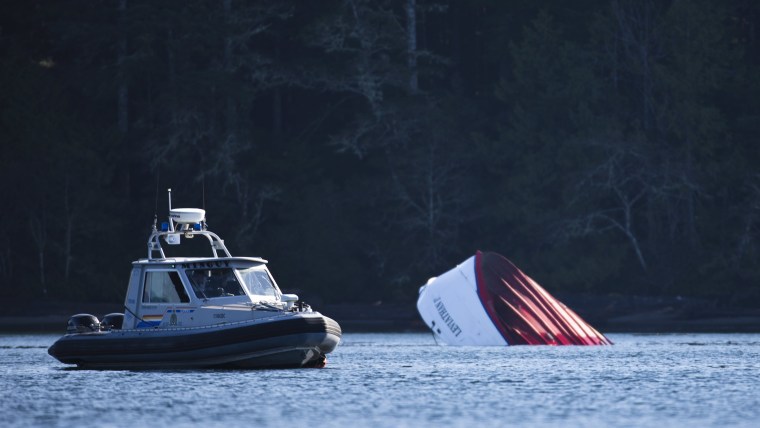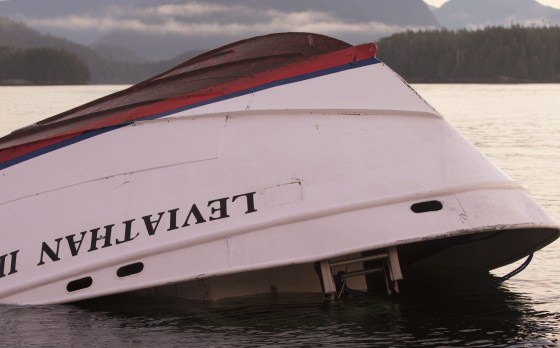Canadian authorities continued to search Tuesday for a lone passenger still missing following the capsizing of a whale watching boat that sunk along Canada’s western shores.
More than two dozen terrified passengers were tossed into the chilly waters off Vancouver Island on Monday, with at least five confirmed dead. Twenty-one others were rescued. A British teenager with Down Syndrome and his dad were the first victims identified in the sinking of the MV Leviathan II, which went down in relatively calm waters.
Related: Whale-Watching Boat Sinks Off British Columbia; 5 Dead, 1 Missing
David Thomas, 50 and his son Stephen, 18, both of Swindon, England, both died in the tragic incident, said Kim West, a spokeswoman for the Swindon Down’s Syndrome Group, which the Thomas family has been a member of since Stephen’s birth.
“We’re all in shock,” West told NBC News, before becoming too upset to continue. “It’s just so terrible.”
Authorities are still searching for the last missing passenger, which The Associated Press described as a 27-year old Australian who was on the boat with his girlfriend and her parents. Her father is believed to be among the fatalities.
Australian government officials could not immediately be reached for comment.
The five victims — four men and a woman — range in ages 18 to 76, said Barbara McLintock, a spokeswoman for the British Columbia Coroner’s Service’s Island Region office. Officials there are expected to announce the identities of all of the victims at a Tuesday afternoon news conference, McLintock said.

Multiple agencies are investigating the capsizing, including Canada’s Transportation Safety Board, Transport Canada, the agency that regulates transportation nationwide, the Royal Canadian Mounted Police and British Columbia’s Coroners Service, according to a Transport Canada spokeswoman.
While Transport Canada will investigate whether the 65-foot vessel complied with Canadian regulations, including whether the boat had adequate life jackets, first aid kits, and fire safety and distress signal equipment, the Transportation Safety Board is leading the probe into what caused the boat to sink.
“We’ll be collecting data, conducting interviews, looking at the [weather] conditions, examining and photographing the wreckage, examining the maintenance history, and reviewing the operation and the policies of the operator,” said Eric Collard, a spokesman for the Transportation Safety Board.
The Leviathan II was inspected annually since 1998, and last inspected on March 6, 2015, said Jillian Glover, a spokeswoman for Transport Canada.
“We’re all in shock. It’s just so terrible.”
The two largest of Jamie’s Whaling Station and Adventure Centres’ fleet are the Leviathan II and The Lady Selkirk, described in an Industry Canada company profile as the west coast’s “only large certified, 65-foot, 49 passenger vessels.”
The profile says that the 36-ton ship was “specifically designed for whale watching and features two Glass Bottom viewing ports.”
A previous Jamie's Whaling Station vessel, Ocean Thunder, capsized in March 1998, killing the boat operator and one of three passengers, according to the findings of a Canada Transportation Safety Board investigation. The deaths were the first ever in British Columbia’s whale-watching industry, the Vancouver Sun reported.
In 1996, a small, unlicensed boat used to pick up Jamie’s customers crashed when the boat operator fell asleep and ran aground, severely injuring the man, according to an earlier TSB report.

